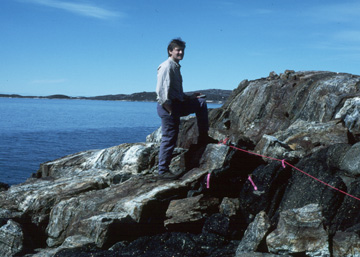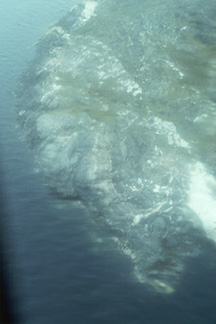Geotimes

Web Extra
Thursday, May 23
Dispute over first
rocks fit for life
Earth's oldest rocks containing what scientists heralded as the earliest evidence
for life are under scrutiny. The rocks in question sit on Akilia Island off
the southwest coast of Greenland. The island hosts a rock exposure of dark green,
almost black, mineral layers alternating with white. Geologists first identified
the outcrop as containing banded iron formations: a type of sedimentary rock
precipitated from seawater.
In this week's Science, a new geochemical analysis of the Akilia Island rocks
claims the outcrop is not sedimentary but igneous - formed in the mantle under
conditions too hot to support life. "It would be like going to Hawaii and
seeing a lava fountain and looking for life inside that," says sedimentary
geologist Christopher Fedo of George Washington University, in Washington.
 Fedo and Martin
Whitehouse of the Swedish Museum of Natural History are casting a shadow of
doubt over the earlier work of Stephen Mojzsis of the University of Colorado
in Boulder. In 1996, Mojzsis and colleagues identified the rocks as banded iron
formations with cross-cuts of tonalite that indicated an age of 3.85 billion-years
old. To determine if evidence for life existed in these rocks, some of Earth's
oldest, they studied the inclusions of graphite in the Akilia outcrop and concluded
that the isotopic signature of the carbon came from biological origins.
Fedo and Martin
Whitehouse of the Swedish Museum of Natural History are casting a shadow of
doubt over the earlier work of Stephen Mojzsis of the University of Colorado
in Boulder. In 1996, Mojzsis and colleagues identified the rocks as banded iron
formations with cross-cuts of tonalite that indicated an age of 3.85 billion-years
old. To determine if evidence for life existed in these rocks, some of Earth's
oldest, they studied the inclusions of graphite in the Akilia outcrop and concluded
that the isotopic signature of the carbon came from biological origins.
Martin Whitehouse on what he considers
distinctly not banded iron formation on Akilia Island. Photo by Chris Fedo.
While Fedo and Whitehouse support analyzing graphite particles for evidence
of life in deep-sea sedimentary rocks, they don't believe the Akilia rocks fit
the sedimentary requirement. Fedo and Whitehouse identified the white quartz
layer as having a geochemistry strongly diluted from, but closely related to,
the green pyroxene in the rocks. In the banded iron formation explanation, the
pyroxene is considered a secondary intrusion of ultramafic igneous rock, creating
veins that are not related to the origin of the white quartz layer. Indeed,
Mojzsis says the white layers are quartz-magnetite, impossible to derive from
an ultramafic rock. "That would mean a chimera of bizarre geological forces
acting on a five-by-50-meter square area of Greenland," Mojzsis says. Fedo
and Whitehouse argue that the magnetite makes up only half a meter of the total
5 meter-thick lithology, and that the presence of magnetite may have come from
a metamorphic breakdown of another mineral or from hydrothermal alteration.
 The differences
might be linked to looking at a marbled cake and watching bakers argue over
its ingredient list. But even when the Akilia rocks are geochemically analyzed
the geologists come up with two separate lists. One for a marine sedimentary
banded iron formation and the other for a metasomatized ultramafic igneous origin.
But Fedo and Whitehouse are distinct in that they take into account the severe
deformation of the outcrop, Peter Appel of the Geological Survey of Denmark
and Greenland.
The differences
might be linked to looking at a marbled cake and watching bakers argue over
its ingredient list. But even when the Akilia rocks are geochemically analyzed
the geologists come up with two separate lists. One for a marine sedimentary
banded iron formation and the other for a metasomatized ultramafic igneous origin.
But Fedo and Whitehouse are distinct in that they take into account the severe
deformation of the outcrop, Peter Appel of the Geological Survey of Denmark
and Greenland.
"I have visited the Akilia outcrops several times and was never convinced
of the sedimentary origin of the quartz-pyroxene rocks in which the carbon was
found," Appel says. "On the contrary a metasomatic origin is very
convincing. This is supported by field evidence in the Isua [Greenland] greenstone
belt, which is probably of the same age as the Akilia supracrustals."
A helicopter view of the disputed rock
exposures on Akilia Island, Greenland. Photo by Chris Fedo.
Fedo and Whitehouse began working with some 40 other researchers in 1997 to
study banded iron formations in Isua. When the weather was too poor for helicopters
to fly into Isua, often the scientists would opt for the shorter trip from the
airport to Akilia. As they continued to return to Greenland each field season,
"the Akilia story had been weighing increasingly on a number of our minds,"
Fedo says.
"Initially I had no intention to work on this stuff because I thought
it was largely a done deal. After a couple of years of revisiting this place
I was deeply concerned that the banded iron formation interpretation was wrong.
Because the rock doesn't look anything like banded iron formation, at least
it didn't to me," he says, adding that "It doesn't physically and
it doesn't chemically."
Christina Reed
Link to:
Science
 Fedo and Martin
Whitehouse of the Swedish Museum of Natural History are casting a shadow of
doubt over the earlier work of Stephen Mojzsis of the University of Colorado
in Boulder. In 1996, Mojzsis and colleagues identified the rocks as banded iron
formations with cross-cuts of tonalite that indicated an age of 3.85 billion-years
old. To determine if evidence for life existed in these rocks, some of Earth's
oldest, they studied the inclusions of graphite in the Akilia outcrop and concluded
that the isotopic signature of the carbon came from biological origins.
Fedo and Martin
Whitehouse of the Swedish Museum of Natural History are casting a shadow of
doubt over the earlier work of Stephen Mojzsis of the University of Colorado
in Boulder. In 1996, Mojzsis and colleagues identified the rocks as banded iron
formations with cross-cuts of tonalite that indicated an age of 3.85 billion-years
old. To determine if evidence for life existed in these rocks, some of Earth's
oldest, they studied the inclusions of graphite in the Akilia outcrop and concluded
that the isotopic signature of the carbon came from biological origins. 
 The differences
might be linked to looking at a marbled cake and watching bakers argue over
its ingredient list. But even when the Akilia rocks are geochemically analyzed
the geologists come up with two separate lists. One for a marine sedimentary
banded iron formation and the other for a metasomatized ultramafic igneous origin.
But Fedo and Whitehouse are distinct in that they take into account the severe
deformation of the outcrop, Peter Appel of the Geological Survey of Denmark
and Greenland.
The differences
might be linked to looking at a marbled cake and watching bakers argue over
its ingredient list. But even when the Akilia rocks are geochemically analyzed
the geologists come up with two separate lists. One for a marine sedimentary
banded iron formation and the other for a metasomatized ultramafic igneous origin.
But Fedo and Whitehouse are distinct in that they take into account the severe
deformation of the outcrop, Peter Appel of the Geological Survey of Denmark
and Greenland. 